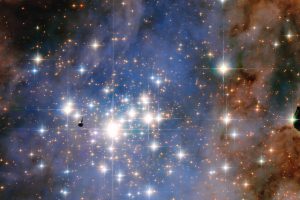A first homogeneous study on the dynamics of stellar clusters. The paper: “The Gaia-ESO Survey: 3D dynamics of young groups and clusters from GES and Gaia EDR3” of N. J. Wright (Keele University) recently appeared on MNRAS

Stars do not form in isolation. During gravitational collapse, molecular clouds fragment, forming a large number of stars. For this reason, young stars are typically observed as members of star clusters or associations.
In the past decade, the study of stellar clusters in the Milky Way has undergone a revolution, thanks to observations from the Gaia satellite of the European Space Agency. By combining photometric, spectroscopic, and kinematic observations, Gaia enables the selection of stars associated with star clusters and associations with unprecedented precision up to distances of about 6000 light years from the Sun. It also allows for the derivation of properties such as their ages, crucial for studies on the evolution of star clusters.
For instance, there is a notable decline in the number of clusters as they age. This decline is attributed to the dispersal of stars associated with star clusters, typically occurring within tens to hundreds of millions of years. This process is influenced by various factors, including the dispersal of the parental cloud from which the cluster formed, resulting in a decrease in the gravitational attraction of the cluster. Additionally, supernova explosions at the end of the evolution of massive stars and tidal interactions with the Milky Way contribute to this dispersal. Among these processes, a prominent role is played by the dynamical interaction between the stars within the cluster.
The study of the dynamical evolution of star clusters is a complex task, as it involves estimating the velocity of each cluster member in three directions, along with accurately measuring the mass of the cluster and its parental cloud if still present. Gaia enables the precise measurement of the projected velocity of stars on our sky, for example, along the right ascension and declination. The third component, the radial velocity, can be derived from spectroscopic measurements, taking advantage of the Doppler effect. This is one of the objectives of the Gaia-ESO Survey, an observational campaign conducted with the FLAMES spectrograph at the 8m Very Large Telescope of the European Southern Observatory. The survey provided spectra for over 100000 stars, including 62 stellar clusters.
The team of researchers led by the astronomer N. J. Wright, from the Astrophysics Group at Keele University, has homogeneously analyzed data from Gaia and the Gaia-ESO Survey of stars associated with 18 clusters younger than 20 million years. The team determined the 3D velocity of each observed star, using which they constructed distributions of stellar velocities for each cluster. From these distributions, it was possible to derive the velocity dispersion of each cluster, indicating the range of velocities covered by the stars in each cluster. For example, a small velocity dispersion suggests a narrow distribution, indicating that most stars in the cluster have similar velocities.
By measuring the mass of the stars and the clouds associated with the clusters, the team also compared the dispersion velocity of each cluster with the value corresponding to a dynamical equilibrium. They observed that, in all clusters, the velocity dispersion is larger than the value at equilibrium, a condition astronomers refer to as “super-virial“. Additionally, all clusters, except for the young cluster Rho Ophiuchi, are expanding. In conclusion, the analysis suggests that all these clusters, likely with the exception of Gamma Velorum, Trumpler 14, and Lambda Orionis, are destined to disperse. The study is detailed in the paper titled “The Gaia-ESO Survey: 3D dynamics of young groups and clusters from GES and Gaia EDR3“, recently published in The Monthly Notices of the Royal Astronomical Society. Among the coauthors is astronomer L. Prisinzano from INAF – Astronomical Observatory of Palermo.
The cover figure (click here to visualize it entirely) shows the young open cluster Trumpler 14, observed in the near-infrared bands by the Hubble Space Telescope.
Mario Giuseppe Guarcello ( follow mariospiegacose) ( mariospiegacose) ( follow mariospiegacose)
Follow the Astronomical Observatory of Palermo on Facebok and on Instagram
Subscribe the Youtube channel of the Astronomical Observatory of Palermo
